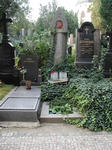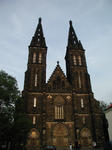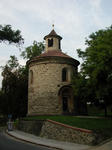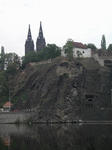 Vysehrad metro station, line C
Vysehrad metro station, line C
Vysehrad means "castle on the heights".
A step cliff overlooking the river Vltava has been associated with the myth of the foundation of the Czech State and Prague itself. Legend has it that it was here the legendary founders of the Premyslid dynasty, Libuse and Premysl, resided, and where Libuse prophesied the town eternal glory "touching upon the stars".
The medieval legend, revived at the Romantic period, has been confronted with a more sober scientific conclusion that while there are indeed traces of human settlement on this site dating from as early as 4000B.C., the medieval fortress of Vysehrad is actually younger then Prague Castle. This notwithstanding, while visiting Vysehrad and walking through the park decorated with statues by J. V. Myslbek on themes from old Bohemian legends, or admiring a view of the river and the city from the top of the cliff one is very likely to succumb to the illusion and believe the ancient legends.
Impossible to get lost within the walls of the former fortress, wherever you go you are certain to find something of interest. Just behind the majestic Leopold Gate built in 1670 stands the Romanesque St. Martin's rotunda, the earliest preserved structure in Vysehrad.
In the building of the Old Deanery visitors can inspect  the foundation of the St. Lawrence basilica, while the New Deanery is frequently the value of concerts and literary programmes. Apart from a number of statues, the park is also known for its mysterious "devil's stones" and the remains of the earliest stone bridge in Prague. Vysehrad's most familiar landmark is the chapter church of St. Peter and Paul, originally built in the Romanesque style, but rebuilt many times, most recently in the 19th century by architects Mocker and Mikes in neo-Gothic style.
the foundation of the St. Lawrence basilica, while the New Deanery is frequently the value of concerts and literary programmes. Apart from a number of statues, the park is also known for its mysterious "devil's stones" and the remains of the earliest stone bridge in Prague. Vysehrad's most familiar landmark is the chapter church of St. Peter and Paul, originally built in the Romanesque style, but rebuilt many times, most recently in the 19th century by architects Mocker and Mikes in neo-Gothic style.
Vysehrad, emblazoned with legends, including the primary national myth, was in the mid-19th century selected as the most suitable of places for a national cemetery which would be resting place for the nation's elite. In the 1880s, the chairman of the Smichov district council P. Fisher had a large monument knows as Slavin (Pantheon) built on the site of a medieval cemetery after a design of architect A. Wiehl.
Fifty-one of the foremost Czech artists, scientists and politicians have so far been buried at Slavin, and the graves of 500 other major figures can be found elsewhere in the cemetary. With most of the gravestones the work of leading Czech sculptors, this is yet another of Prague's open-air art galleries.
Permanent exhibition of Vysehrad history open daily:
April - October: 09:30 - 17:30
November - March: 09:30 - 16:30



 Průvodce
Průvodce 





